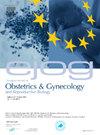癫痫发作预测孕妇癫痫:临床实践指南和系统评价的总括性回顾
IF 1.9
4区 医学
Q2 OBSTETRICS & GYNECOLOGY
European journal of obstetrics, gynecology, and reproductive biology
Pub Date : 2025-03-10
DOI:10.1016/j.ejogrb.2025.03.022
引用次数: 0
摘要
目的探讨孕妇及普通癫痫患者癫痫发作的危险因素。研究设计:对孕妇癫痫患者、成人癫痫患者或所有癫痫患者癫痫发作的危险因素或预测模型的临床实践指南和系统评价进行总括性回顾。排除了专门针对儿童的指南或系统评价。我们检索了MEDLINE、Emcare、Embase、CINAHL、TRIP PRO、Epistemonikos、世界卫生组织、guidelines International Network、DANS和灰色文献(2000-2023),没有语言限制。对最终指南或系统评价中列出的风险因素或预测因素进行整理和专题分析。结果从3406次引用中,我们纳入了13篇文章(10篇指南,3篇系统评价),报告了孕妇和普通成人癫痫患者的26个危险因素:8个因素仅适用于孕妇;孕妇和一般成年人中均有5例(指南和系统评价中均有4例,仅指南中有1例);一般成年人中有13个因素(指南和系统评价中有4个,指南中有8个,系统评价中有1个)。危险因素分为五大主题:癫痫发作类型;癫痫发作控制;抗癫痫药物;神经系统;还有癫痫和病史癫痫发作的三个危险因素在两个以上的指南或系统评价中被引用:癫痫发作自由(降低风险)、首次发作后立即开始抗癫痫药物治疗(降低风险)和脑电图异常(增加风险)。三个危险因素与孕妇癫痫发作的两倍以上几率相关:最近三个月的强直阵挛发作(RR 7.20, 95% CI 6.63-11.93),非强直阵挛发作史(RR 2.11, 95% CI 1.88-2.62),以及与无癫痫发作相比,妊娠前一年的癫痫发作(RR 3.51, 95% CI 3.13-3.94)。结论不同的指南和综述建议在实践中使用多种危险因素,以确定成年癫痫患者,特别是孕妇癫痫患者癫痫发作风险增加的因素。需要进一步研究实施预测癫痫发作的工具,以改善孕产妇和新生儿的结局。本文章由计算机程序翻译,如有差异,请以英文原文为准。
Seizure prediction in pregnant women with epilepsy: An umbrella review of clinical practice guidelines and systematic reviews
Objective
To identify risk factors for seizure in pregnant women, and in the general population with epilepsy.
Study design
Umbrella review of clinical practice guidelines and systematic reviews on risk factors or prediction models for seizure occurrence in pregnant women with epilepsy, adults with epilepsy, or all individuals with epilepsy. Guidelines or systematic reviews exclusively for children were excluded. We searched MEDLINE, Emcare, Embase, CINAHL, TRIP PRO, Epistemonikos, World Health Organisation, Guideline International Network, DANS, and grey literature (2000-2023) without language restrictions. Risk factors or predictors listed in the final guidelines or systematic reviews were collated and thematically analysed.
Results
From 3406 citations, we included 13 articles (ten guidelines, three systematic reviews) reporting 26 risk factors in pregnant women and the general adult population with epilepsy: eight factors in guidelines for pregnant women only; five in both pregnant women and general adult populations (four in both guidelines and systematic reviews, one in guidelines only); and 13 factors in the general adult population (four in both guidelines and systematic reviews, eight in guidelines, and one in a systematic review). Risk factors were categorised into five broad themes: seizure type; seizure control; anti-seizure medication; neurological; and epilepsy and medical history. Three risk factors for seizure ocurrence were cited in more than two guidelines or systematic reviews: seizure freedom (reduced risk), immediate initiation of anti-seizure medication after first seizure (reduced risk), and abnormal electroencephalogram (increased risk). Three risk factors were linked to a more than two-fold chance of seizures in pregnant women with epilepsy: tonic-clonic seizures in the last three months (RR 7.20, 95% CI 6.63-11.93), a history of non-tonic-clonic seizures (RR 2.11, 95% CI 1.88—2.62), and seizures in the pre-pregnancy year compared to no seizures (RR 3.51, 95% CI 3.13-3.94).
Conclusion
Multiple risk factors have been recommended for use in practice across different guidelines and reviews to identify those at increased risk of seizures in the adult population with epilepsy, and specifically in pregnant women with epilepsy. Further research is needed on the implementation of tools for predicting seizures to improve maternal and neonatal outcomes.
求助全文
通过发布文献求助,成功后即可免费获取论文全文。
去求助
来源期刊
CiteScore
4.60
自引率
3.80%
发文量
898
审稿时长
8.3 weeks
期刊介绍:
The European Journal of Obstetrics & Gynecology and Reproductive Biology is the leading general clinical journal covering the continent. It publishes peer reviewed original research articles, as well as a wide range of news, book reviews, biographical, historical and educational articles and a lively correspondence section. Fields covered include obstetrics, prenatal diagnosis, maternal-fetal medicine, perinatology, general gynecology, gynecologic oncology, uro-gynecology, reproductive medicine, infertility, reproductive endocrinology, sexual medicine and reproductive ethics. The European Journal of Obstetrics & Gynecology and Reproductive Biology provides a forum for scientific and clinical professional communication in obstetrics and gynecology throughout Europe and the world.

 求助内容:
求助内容: 应助结果提醒方式:
应助结果提醒方式:


